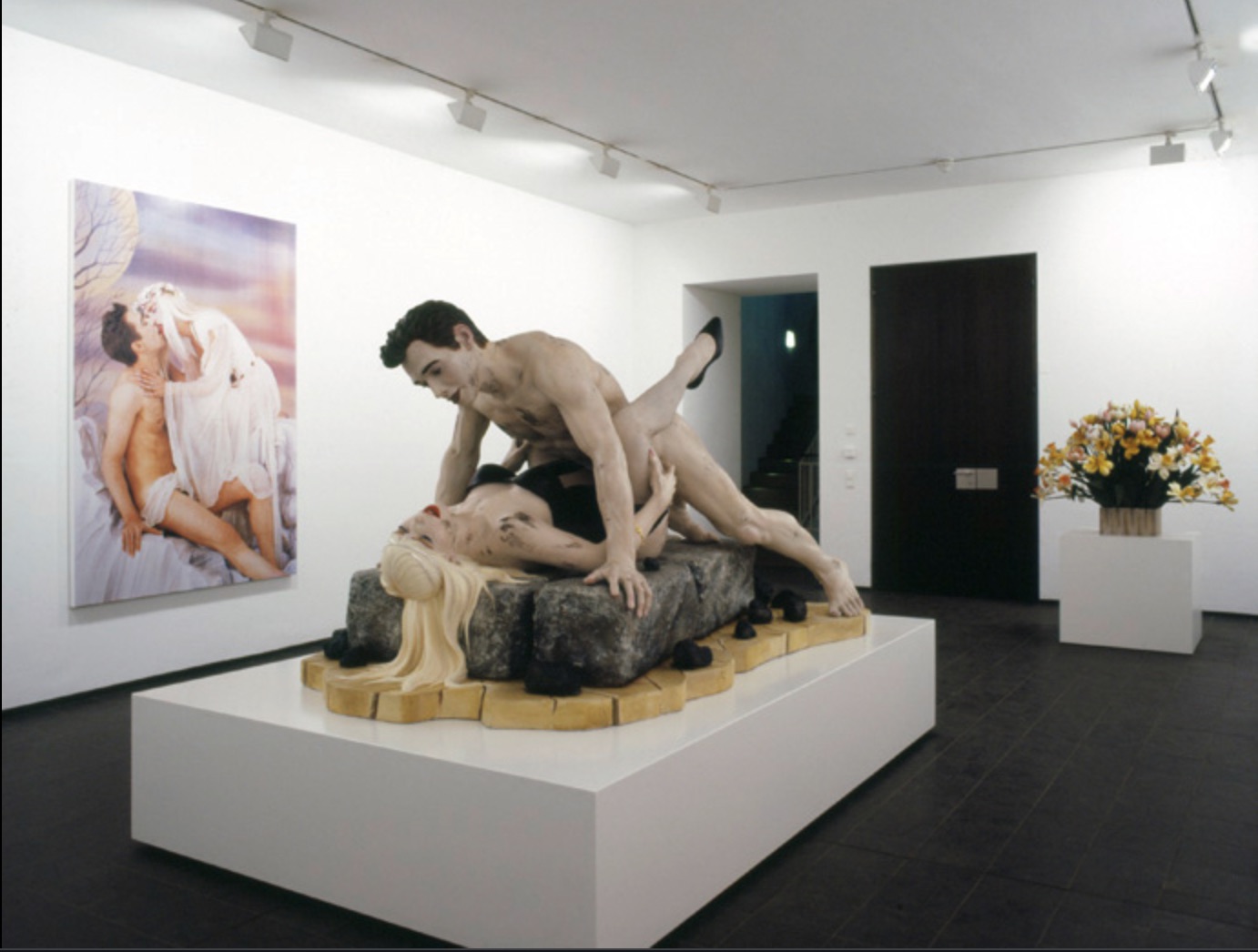Superstar artist Jeff Koons has been sued for appropriating the work of others—again. The latest lawsuit, Hayden v. Koons, was filed last December in federal court. It concerns a series of works, “Made in Heaven,” that depict the sexual exploits of Koons and his ex-wife, the Italian porno star, “La Cicciolina” (little chubby one). At the Whitney’s 2014 Koons retrospective I had the misfortune of viewing blown-up photos of the couple vigorously copulating, including views of Koons’ genitals. I left the Whitney feeling the show should have been labeled “Made in Hell.”
The plaintiff in the suit, Michael Hayden, is a set designer for films and the creator of the platform upon which La Cicciolina “performed” in Italian porn movies. The lawsuit concerns a sculptural work from “Made in Heaven”—a life-size image of Koons mounting his inamorata, who was wearing lingerie and stiletto heels, on a pedestal of faux boulders with serpent.
Hayden in his complaint alleges with a straight face, “The intended purpose of the Hayden Work was to serve as a work of fine art on which Cicciolina could perform sexually explicit scenes, both live and on camera,” and that Hayden did not intend that his work “would be used commercially by anyone other than Cicciolina.”
The lawsuit claims that Koons appropriated the “exact” Hayden sculpture in “Made in Heaven” (1989) three times—for a lithograph initially commissioned by the Whitney Museum and first displayed as a giant billboard towering over downtown Manhattan, as the polychromed wood sculpture, and then in an oil painting entitled Jeff in the Position of Adam.
The “Made in Heaven” series catapulted Koons to fame—exactly what Koons intended according to an interview on the Whitney’s website quoted in the lawsuit: “I thought you know what I’ll do? I’ll create this billboard that’s advertising a film. I’ll call it Made in Heaven, and it’ll be starring myself …It’ll be like I became another star …” Koons is utterly shameless.

What a ride! From Jeff Koons’ series “Made From Heaven,” 2014.
In recent years Koons has faced a series of infringement suits. A case filed by a photographer claimed that Koons painted and sold an unauthorized copy of a Gordons Gin ad virtually identical to the version published in magazines. That suit dates back to a series of liquor ads Koons copied and painted in the late 1980s. In 2018 Koons lost a trial in France concerning yet another infringement claim stemming from his “Banality” series.
Koons usually defends these suits by invoking the exception to copyright infringement known as “fair use.” In the art world the issue boils down to whether the subsequent use of another artist’s copyrighted image is transformational.
This column previously examined two major decisions concerning Koons’ alleged infringement. The first, Rogers v. Koons (1992), involved the image of a group of eight German Shepherd puppies that photographer Art Rogers had taken and reproduced on postcards sold to the public. Koons, who rendered the image into a wooden glossy multicolored sculpture String of Puppies, sold an edition of four in 1986.
The Puppies work was part of Koons’ “Banality” series that included the widely-known sculpture of Michael Jackson reclining with his pet chimp, Bubbles. Koons claimed that not only had he substantially transformed the image, but Rogers’ photo was the epitome of the banality he was parodying. The court held in Rogers’ favor, finding that Koons had failed to substantially transform the original image.
In a 2006 infringement case, Blanch v. Koons, another federal judge came to the opposite conclusion. Koons used a copyrighted photo published in a magazine, taken by plaintiff Andrea Blanch, a fashion photographer. The photo contained an erotic image of a model’s legs, which Koons incorporated into a painting titled Niagara, that included photos of other women’s legs, trays of donuts and Niagara Falls. The court found that Koons’ use of the image was transformative, noting that Koons altered the original photo’s “colors, the background against which it is portrayed, the medium, the size of the objects pictured, their details and crucially, their entirely different purpose and meaning …” In testimony, Koons explained that he was commenting on the banality of common imagery in advertising.
In the Hayden case, Koons may proffer the additional defense that he was engaging in a parody by inserting himself, a former investment banker, into salacious imagery with a famous porn queen. Courts have long recognized that parodies lie within the fair use exception to infringement. However, Koons may find that while he may have intended “Made in Heaven” to be a parody, consistently failing to obtain a license to use others’ copyrighted artwork is no laughing matter.

